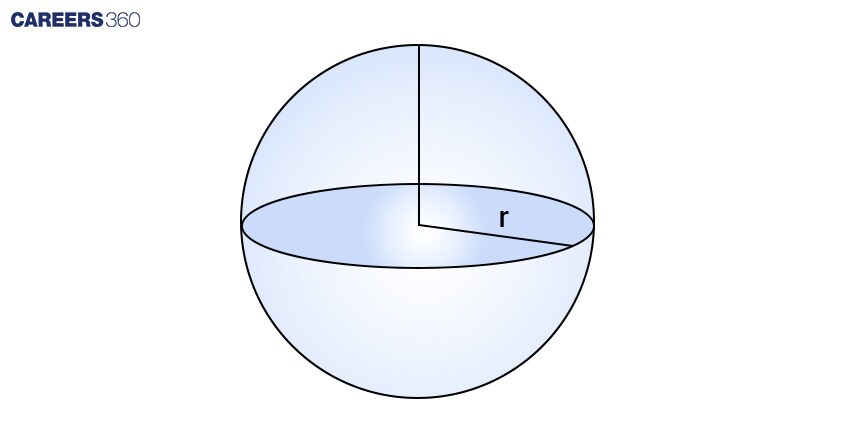Sphere and Hemisphere: Definition, Formula, Difference, Questions
The sphere and hemisphere are important parts of 3d geometry or menstruation. A sphere is a 3 dimensional form of a circle and a hemisphere is nothing but half of the sphere. In this article, we will discuss ‘sphere and hemisphere formula’, ‘sphere and hemisphere difference’, ‘sphere and hemisphere diagram’, ‘sphere and hemisphere volume formula’, ‘sphere and hemisphere shape’, ‘sphere and hemisphere questions’ etc.
CAT 2024: 20 Free Mock Test | 10 Year PYQs | 60 Day Study Material | Most Scoring Concepts
XAT 2025: Section-wise Preparation Tips | Sample Paper
Don't Miss: SNAP 2024 Sample Papers | NMAT 2024 Sample Papers | MAT 2024 Sample Papers
You will also find ‘sphere and hemisphere worksheet’, ‘sphere and hemisphere volume worksheet’ and you will need sphere and hemisphere volume formulas to solve the related questions.
Sphere and Hemisphere: An Overview
The sphere and hemisphere are some of the important topics in mensuration. A sphere has only one plane which is a curve plane. A hemisphere has one curved plane and one flat plane. Spheres are round in shape, and if we cut a sphere into two equal halves we will get two equal hemispheres.
Defining a Sphere
A sphere is defined as the set of all points in space that are equidistant from a fixed point, known as the centre. Some examples of a sphere include a basketball, a soap bubble, a tennis ball, etc. The important elements of a sphere are as follows:
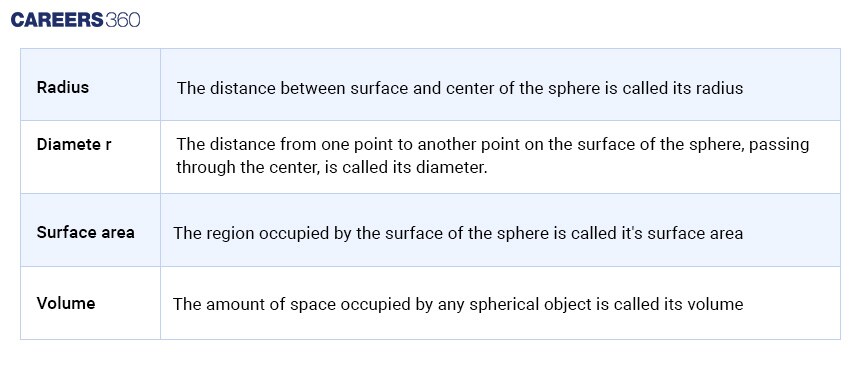
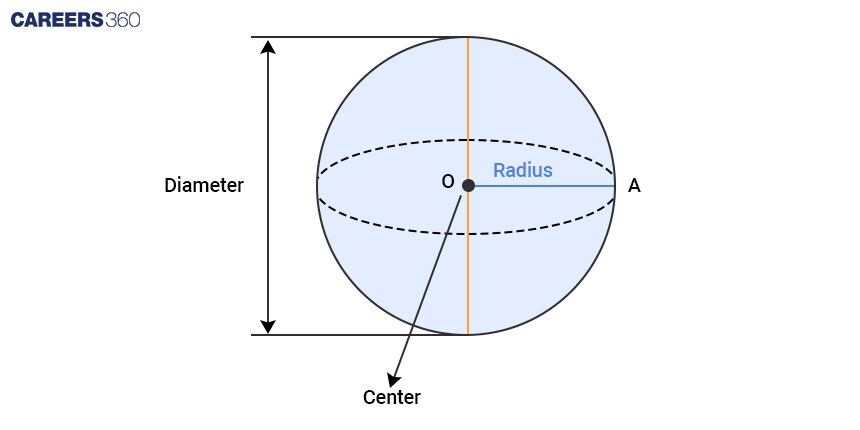
Shape of a sphere
The shape of a sphere is round and it does not have any faces. The sphere is a geometrical three-dimensional solid having a curved surface. Like other solids, such as cubes, cuboids, cones, and cylinders, a sphere does not have any flat surface, a vertex, or an edge. Some real-life examples, which have a spherical shape are Basketball, a Globe, Marble, Orange etc.

Properties of a Sphere
The properties of a sphere are as follows:
It is perfectly symmetrical in all directions.
It has only a curved surface area.
It is not a polyhedron as it has no edges, vertices, or flat faces.
All the points on the surface of a sphere are equidistant from the center
Among all the shapes with the same surface area, the sphere would have the largest volume.
Equation of a sphere
The equation of a sphere in three-dimensional Cartesian coordinates with the centre at
When the centre is at origin (0,0,0) the equation becomes
The surface area of a Sphere
The surface area of a sphere is the total area covered by the surface of a sphere in a three-dimensional space. It is measured in square units. The formula of surface area is given by:
Volume of a Sphere?
The amount of space occupied by a sphere is called the volume of the sphere. It is measured in cubic units. The formula of volume is given by
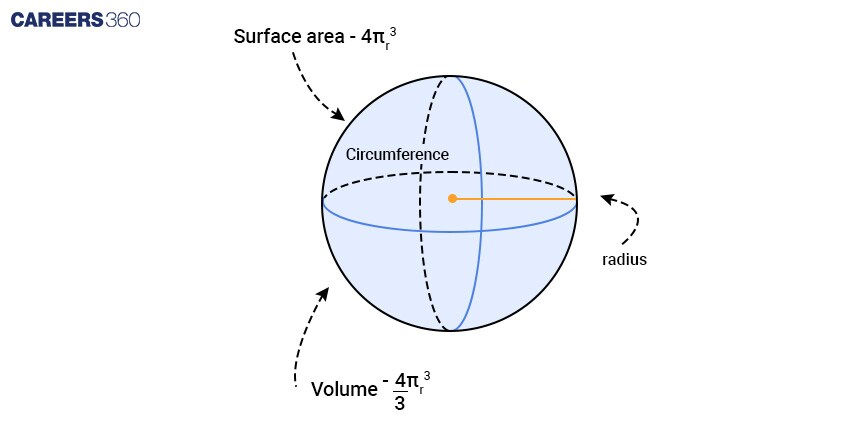
Difference between a sphere and a circle
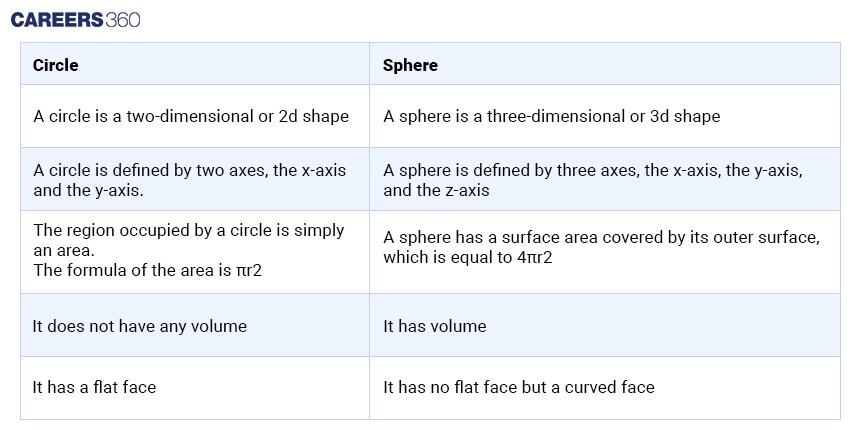
What is a Hemisphere?
A hemisphere is half of a sphere, typically divided by a plane passing through the centre. It retains many properties of a sphere but is flat on one side.
Properties of a Hemisphere
The properties of a sphere are as follows:
A hemisphere has a curved surface and a flat surface.
Just like a sphere, there are no edges and no vertices in a hemisphere.
A hemisphere is not a polyhedron since it has a circular base and one curved surface.
The radius of the hemisphere is equal to the radius of the sphere.
Surface Area of a Hemisphere
The surface area of a hemisphere can be calculated by the area of its circular base along with its curved surface. The hemisphere can either be hollow or solid, according to that the surface area can be calculated. It is measured in square units and there are two types of surface area of a hemisphere.
Curved Surface Area of a Hemisphere
The curved surface of a hemisphere is considered the lateral area of a hemisphere and it can be calculated using the formula:
The curved surface area of a hemisphere =
The whole surface area of a Hemisphere
The whole surface area or the total surface area of a hemisphere is the sum of its curved surface area and the area of the circular base.
So, the whole surface area of a hemisphere =
Volume of a Hemisphere
The volume of a hemisphere is the total capacity of the hemisphere and it is the number of cubic units covered inside that space. The volume of a hemisphere is calculated using the formula:
The volume of a hemisphere =
Difference between Sphere and Hemisphere
Sphere | Hemisphere |
The sphere has no flat side and is only curved. | The hemisphere has one flat side and one curved side. |
The volume of a sphere = | The volume of a hemisphere = |
The sphere has only one surface area. | The hemisphere has two surface areas i.e. a curved surface area (CSA) and a whole surface area. CSA = |
The total surface area of a sphere = | The total surface area of a hemisphere = |
List of Formulas:
Curved Surface Area | Total Surface Area | Volume | Diagram | |
Sphere | - |
| ||
Hemisphere |
|
Practice Questions/Solved Examples
Q.1.
Three solid metallic spheres of radii 1 cm, 6 cm, and 8 cm, respectively, are melted and recast into a single solid sphere. The radius of the new sphere formed is:
9.0 cm
5.9 cm
7.7 cm
8.5 cm
Hint: Use this formula: Volume of a sphere =
Solution:
Given: The three original spheres had radii of 1 cm, 6 cm, and 8 cm, respectively.
Volume of a sphere
The total volume of the three original spheres
Let the radius of the new sphere formed be
The volume of the new sphere = Sum of the volumes of the original spheres
⇒
⇒
⇒
So, the radius of the new sphere formed is 9.0 cm.
Hence, the correct answer is 9.0 cm.
Q.2.
If the inner radius of a hemispherical bowl is 5 cm and its thickness is 0.25 cm, find the volume of the material required to make the bowl. (Use
(Rounded up to two decimal places).
34 cm3
44 cm3
45.34 cm3
41.28 cm3
Hint: The formula to find the volume of a hemispherical bowl with inner radius
Solution:
Volume of the hemispherical bowl =
Where,
And,
So, the volume
Hence, the correct answer is 41.28 cm3.
Q.3.
If the diameter of a sphere is 7 cm, find the volume of the sphere. (use
Hint: Volume of a sphere =
Solution:
Given: The diameter of a sphere is 7 cm.
Volume of the sphere =
Volume of the sphere
Hence, the correct answer is
Q.4.
A ball is to be made with an inner radius of 2 units and an outside radius of 3 units. How much material is required to make the ball?
Hint: The volume of a spherical shell is
Solution:
Given: Inner radius of 2 units and outside radius of 3 units.
The volume of a spherical shell is
Hence, the correct answer is
Q.5.
The radius of a sphere is doubled. The percentage increase in its surface area is ______.
75%
100%
300%
400%
Hint: Use the formula: The surface area of a sphere =
Solution:
Let the radius of the sphere be
So, the surface area of the sphere =
After doubling, the new radius = 2
So, the new surface area =
Hence, the correct answer is 300%.
Q.6.
The length of the largest possible rod that can be placed in a cubical room is
3500
3850
2450
4250
Hint: Use the formula: The radius of the largest possible sphere that fits within a cubical room =
Solution:
Given: The length of the largest possible rod that can be placed in a cubical room is
The length of the largest rod = diagonal of the cube = side ×
Here, side ×
Or, the side of the cube = 35 metres
Now, the radius of the largest possible sphere that fits within the cubical room =
Therefore, the surface area of the sphere:
=
=
= 3850 sq. metres
Hence, the correct answer is 3850.
Q.7.
What is the surface area (in cm²) of a spherical sculpture whose radius is 35 cm?
(Take
16540
15700
15400
14500
Hint: Use the formula: Surface area of sphere =
Solution:
The radius of spherical sculpture,
Surface area of sphere =
=
= 15400 cm2
Hence, the correct answer is 15400.
Q.8.
A hemispherical bowl has a radius of 7 cm. It is to be painted from inside as well as outside. Find the cost of painting it at the rate of Rs. 40 per 20 cm2. (Take the thickness of the bowl as negligible).
Rs. 1,232
Rs. 1,125
Rs. 1,432
Rs. 1,550
Hint: Use the formula: Curved surface area of hemisphere =
Solution:
The radius of the hemispherical bowl = 7 cm.
Curved surface area =
Inner and outer surface area of the bowl =
=
= 616 cm2
Total cost of painting at the rate of Rs. 40 per 20 cm2
=
Hence, the correct answer is Rs. 1,232.
Q.9.
The volume of a sphere of radius 4.2 cm is: (Use
278.234 cm3
312.725 cm3
297.824 cm3
310.464 cm3
Hint: The volume
Solution:
The volume
Putting
Hence, the correct answer is 310.464 cm3.
Q.10.
A spherical ball of lead, 3 cm in diameter, is melted and recast into three spherical balls. The diameters of two of these balls are
2.1 cm
3.3 cm
3 cm
2.5 cm
Hint: The volume of the sphere is
Solution:
Given:
A spherical ball of lead, 3 cm in diameter, is melted and recast into three spherical balls.
Radius =
So, the volume of the sphere =
The diameters of two of the new balls are
Radii of these two balls are
Let the radius of the third ball be
So,
⇒
⇒
⇒
⇒
So, the diameter of the third ball
Hence, the correct answer is 2.5 cm.
Frequently Asked Questions (FAQs)
The formula of volume is given by
A spheroid is a three-dimensional geometric shape that resembles a sphere but is slightly flattened or elongated. It can be classified as an oblate spheroid (flattened at the poles) or a prolate spheroid (elongated along the axis).
A sphere is a perfectly round three-dimensional shape where every point on its surface is equidistant from its centre. It resembles a ball or a globe and has no edges or vertices.
A hollow hemisphere is a three-dimensional geometric shape that represents half of a hollow sphere. It has an outer curved surface and an inner curved surface, with a circular edge connecting the two surfaces. The thickness of the hemisphere is the distance between the inner and outer surfaces.
A hemisphere has two faces: one curved surface and one flat circular base. The curved surface is half of a sphere, and the flat base is a circle where the sphere is divided.

